Egypt’s Red Sea has been a popular scuba diving destination for decades, thanks to its stunning biodiversity and world-class diving conditions. The region is best known for colorful, light-filled coral gardens swarming with tropical fish. These fringing reefs are just the gateway to Egypt’s incredible underwater world, though. Dive a little deeper, and you’ll soon discover much more than what first meets the eye.
In recent years, Egypt’s tourism industry has shrunk down to a shadow of its former self. For savvy divers, that translates to uncrowded dive sites and discount prices, so the time to visit is now. Cash in on your opportunity to explore this incredible region before the crowds of tourists make their comeback.





